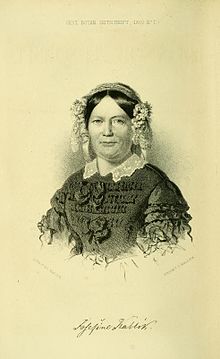Josephine Kablik

Josephine Kablik , also Kabelik (born March 9, 1787 in Hohenelbe , Bohemia ; † July 21, 1863 in Hohenelbe) was a Bohemian, k. k. Austrian botanist and paleontologist . She was particularly interested in the flora of the Giant Mountains . Your botanical author abbreviation is " Kablik ".
Career
Josephine Kablik was born as the daughter of the paper manufacturer David Ettel. At a young age, she became interested in the local flora. Josephine grew up in the family until she was 12. Afterwards she was sent to the convent of the Ursuline Sisters in Prague to train in the female activities customary at the time. After her marriage in 1806 to Adelbert Kablik, she took up studies with the botanist Wenzel Mann (1799–1839) in Prague from 1822 to 1823 . In 1823 she returned to Hohenelbe. She went on extensive excursions and created a systematic herbarium with the plants she had collected . In addition to a general herbarium, she built up an extensive special collection on the vegetation of the Giant Mountains. Kablik took an active part in the Opiz Plant Exchange , which was founded in Prague in 1825 . She sent in around 2,400 plant specimens annually, which were then sent on worldwide. In this way she was able to establish contacts with numerous scientists of her time and with botanical institutes. In addition to plants, Josephine Kablik also collected palaeontological material that found its way into museum and teaching collections. Up until old age, she carried out excursions in Germany, Italy and Switzerland even under adverse weather conditions. She was supported in her research by her husband, who, as a pharmacist, was also interested in science. So the couple created joint collections that were comparable to museum collections.
Scientific work
Through her botanical collecting activities, Josephine Kablik was able to contribute to a better knowledge of the vegetation of the Giant Mountains . She also discovered several new species in the process. In the field of paleontology, she was able to record finds of previously unknown species. Examples are the fossil fish Palaeoniscus Kablikae and the extinct trilobite Kablikia silurica . The two of their originally discovered Urkrebse were of Hanns Bruno Geinitz 1862 in the context of proceedings of the Isis first described and the same place for a correction to strong criticism. 1863 To Dr. JN Eiselt's work The Johannesbader Sprudel and its surroundings she contributed to a description of the flora of the Giant Mountains.
Honors
Several of the species newly discovered by Josephine Kablik were named in her honor. So the plant Rhizolithes Kablikae and the fossil fish Palaeoniscus Kablikae . J. Maly recognized her services to the flora of Germany and Austria in the context of a preface to his Enumeratio plantar. imp. Austria in Vienna in 1848. Gustav Lorinser expressed his appreciation for her in his book Flora Deutschlands und der Schweiz , published in 1847 . Josephine was Kablik in the art installation The Dinner Party by Judy Chicago added.
swell
- Renate Strohmeyer: Lexicon of the natural scientists and women of Europe . Verlag Harri Deutsch, ISBN 3-8171-1567-9 , p. 15
- Oesterreichische Botanische Zeitschrift , Volume X, No. I, Vienna 1860 ( available online )
- Kablik Josephine. In: Austrian Biographical Lexicon 1815–1950 (ÖBL). Volume 3, Verlag der Österreichischen Akademie der Wissenschaften, Vienna 1965, p. 163.
Single receipts
- ↑ Entry at IPNI
- ^ Entry Josephine Kablik at Brooklyn Museum - Elizabeth A. Sackler Center for Feminist Art
literature
- Constantin von Wurzbach : Kablik, Josephine . In: Biographisches Lexikon des Kaiserthums Oesterreich . 10th part. Imperial-Royal Court and State Printing Office, Vienna 1863, p. 342 f. ( Digitized version ).
- Franz Speta: Kablik, Josephine. In: Brigitta Keintzel, Ilse Korotin (ed.): Scientists in and from Austria. Life - work - work. Böhlau, Vienna / Cologne / Weimar 2002, ISBN 3-205-99467-1 , pp. 337–339.
| personal data | |
|---|---|
| SURNAME | Kablik, Josephine |
| ALTERNATIVE NAMES | Kabelik, Josephine |
| BRIEF DESCRIPTION | Bohemian botanist and paleontologist |
| DATE OF BIRTH | March 9, 1787 |
| PLACE OF BIRTH | Hohenelbe , Bohemia |
| DATE OF DEATH | July 21, 1863 |
| Place of death | Hohenelbe , Bohemia |